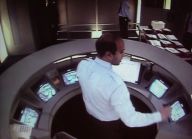Setting up
The Guards had high status and they had high power. This was symbolized by good meals, by superior living conditions, by their privileges, and by their smart uniforms. They had multiple bases of power such as keys to all the doors in the prison and surveillance monitors with which to observe and control the Prisoners.
The Prisoners had low status. This was symbolized by their bad food, their Spartan living conditions, their basic uniforms. They had no formal power – having to do as they were told by the Guards.
Most of all, though, status and power difference was encapsulated in the fact that, on the night before people entered the prison, we gathered the Guards together in a hotel. We told them that their task was to make the prison work, but that it was up to them to decide how best that might be done.
Within certain limits, set largely for ethical reasons, they were given free rein to devise the prison rules. We then printed out the rules and posted them prominently around the prison and in the Prisoners’ cells. Guards could also administer punishments for breaking the rules. These included placing Prisoners in an isolation cell or withdrawing their ‘privilege hour’.
Of course, despite all these features, this was not a real prison. But the differences in power and status were real. So, for us, the prison was intended to represent the range of institutions of unequal power that exist in our society.
Activity
Exercise: Anticipating findings
